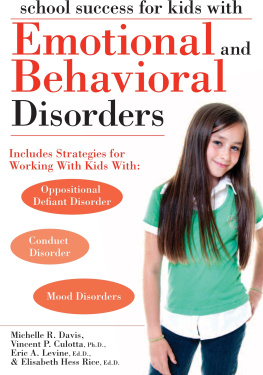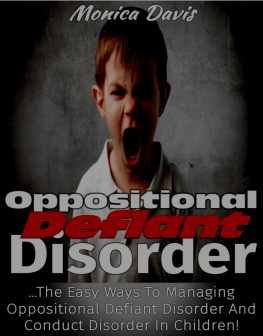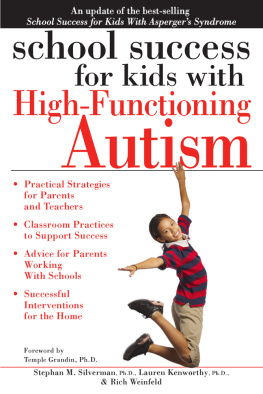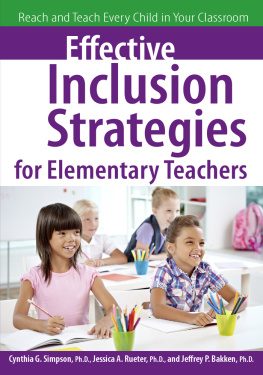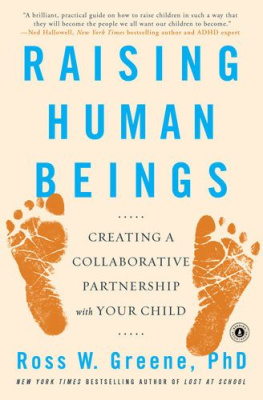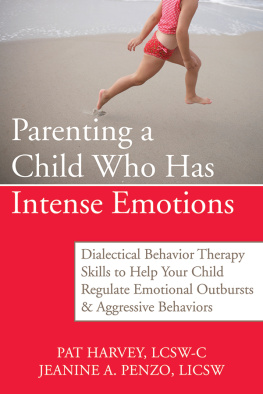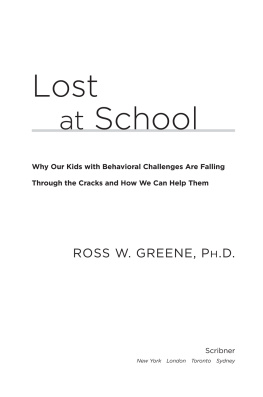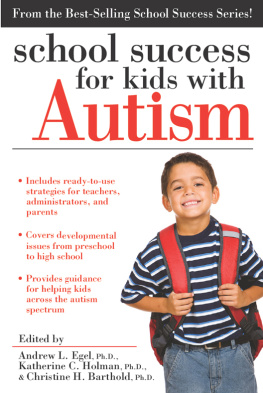school success for kids with
Emotional and
Behavioral
Disorders
school success for kids with
Emotional and
Behavioral
Disorders
Michelle R.Davis,
Vincent P. Culotta, ph.D.,
Eric A. Levine, Ed.D.,
& Elisabeth Hess Rice, Ed.D.
 | P RUFROCK P RESS I NC .
W ACO , T EXAS |
Copyright 2011, Prufrock Press Inc.
Edited by Lacy Compton
Cover and Layout Design by Marjorie Parker
ISBN-13: 978-1-59363-826-9
No part of this book may be reproduced, translated, stored in a retrieval system, or transmitted, in any form or by any means, electronic, mechanical, photocopying, microfilming, recording, or otherwise, without written permission from the publisher.
Printed in the United States of America.
At the time of this books publication, all facts and figures cited are the most current available. All telephone numbers, addresses, and website URLs are accurate and active. All publications, organizations, websites, and other resources exist as described in the book, and all have been verified. The authors and Prufrock Press Inc. make no warranty or guarantee concerning the information and materials given out by organizations or content found at websites, and we are not responsible for any changes that occur after this books publication. If you find an error, please contact Prufrock Press Inc.
 | Prufrock Press Inc.
P.O. Box 8813
Waco, TX 76714-8813
Phone: (800) 998-2208
Fax: (800) 240-0333
http://www.prufrock.com |
Contents
Part I
Background and Perspective
chapter 1
The Many Faces of Students With Challenging Behavior
chapter 2
Learning From History
chapter 3
School Culture and Perception of Challenging Behaviors
Part II
Schools and Classrooms
chapter 4
Schoolwide and Classroom Supports:
Universal and Secondary Prevention Programs
chapter 5
Discipline
Part III
The Individual Child
chapter 6
Evaluating Emotions and Behaviors
chapter 7
Functional Behavior Assessment
chapter 8
Eligibility: Qualifying for Services
chapter 9
Individual Plans
chapter 10
The Brain and Behavior
chapter 11
Diagnoses: What Do They Mean?
chapter 12
Medications
chapter 13
Self-Determination and Self-Advocacy
Acknowledgments
THIS book represents the cumulative experiences of scores of children, adolescents, and families struggling for more than just a good education; many children are challenged to find a sense of identity and value. It is because of these families perseverance that we are able to share their stories and better understand their needs.
Michelle and the authors share appreciation for Maria Hammills excellent contributions in her medical issues chapter. Her empathetic, understanding manner and ability to support families with school demands is unique. Michelles deep gratitude for the support and love from her husband, family, and friends is unending. Michelle is especially grateful for the opportunities she has had to serve her community and the many extraordinary educators who do so every day.
Vince would like to thank his mentors, colleagues, and coauthors who have taught him more from their actions than could be acquired from books. He also wishes to thank Trisha Sanderson for her endless energy, and the staff of NeuroBiological Associates for truly caring about the children we serve. To his wife Cheryl, and daughters Stephanie and Annatheir patience, encouragement, and love remind him why we strive to make a contribution and leave things just a little better than we found them.
Eric acknowledges his wife Gretchen for her wisdom, experience, patience, love, and tolerance over the years. Eric feels fortunate to have had the opportunity to wear many professional hats. Without Gretchens quiet yet thoughtful guidance, it would not have been possible for him to do the things he has been able to do. Eric would like to acknowledge his children Erika and Alex for simply being who they are, his many friends and colleagues, and of course, the children and families with whom he has had the opportunity to serve.
Lisa would like to thank her colleagues at The George Washington University for their support and dedication to preparing teachers for students with the most challenging behaviors. In addition, she would like to acknowledge her husband Lacy for his patience, humor, and unflappable support. Sara, Lacy, and Austin, Lisas children, also deserve recognition because they fuel her passion to advocate for good teachers for all children.
To our editor, Lacy Compton, thank you for your guidance and leadership, keeping us focused on how we best communicate to serve children.
Introduction
Do you know a child or adolescent who is battling depression, anxiety issues, or anger issues? Are you the parent or teacher of a student who is misunderstood and who ends up isolated in the community or in school? This book is about the countless numbers of students and their families who are living with the invisible but very real emotional and behavioral disabilities. These students can shut down and refuse to interact, cut themselves, starve themselves, refuse to follow directions, or incite other students or adults. These students are not helpless or beyond help, they are simply misunderstood and often mistreated. This book tells their stories and offers some basic solutions that are so often ignored in schools.
Challenging behaviors can mask a childs potential, strengths, and talents; interfere with academic success; and impair the fulfillment of a productive and happy life. Parents and teachers who work with students with emotional and behavioral challenges often are desperately searching for information about successful interventions. They are seeking professionals who understand their students and who can tell them how to help. Children and adolescents with challenging behaviors can be successful in school and in life, but they need strength-based, caring interventions. This cannot occur, however, with the current philosophies and practices in place in our schools. Nationally and worldwide, failure to attend to the needs of children with social, emotional, and behavioral challenges could result in a crisis so profound that all of us are likely to be affected. Now is the time to transform our education system and the way we serve and educate students with social, emotional, and behavioral difficulties. There are interventions that work. This book is designed to provide parents and educators with tools for school success, including schoolwide and classroom interventions and evidence-based interventions for individual students.
School success for students with challenging behaviors is one of the most important issues in education, mostly because the societal implications for underserving or misunderstanding this group of children are so great. Students with challenging behaviors whose needs are not met will be adults with poor social skills either unnoticed or noticed for the wrong reasons. Children who suffer with the symptoms of oppositional defiance, mood, conduct, or other disorders often are talented, but their gifts have not been uncovered. They often are situated with one foot in the world of possible unemployment and discord and one foot in the world of possibility. Children with challenging behaviors have the lowest grade point averages, lowest high school graduation rates, and the largest unemployment rates compared to any other group. Educators and parents have a ripe opportunity to now take advantage of the educational research and understanding of biological and brain-based factors for challenging behavior and transform education for this important and growing group of students.
Next page
